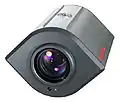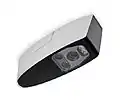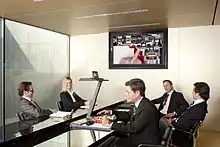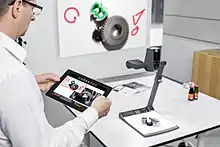WolfVision
WolfVision GmbH is a manufacturer of presentation, collaboration, and knowledge sharing systems based in the Vorarlberg region of Austria. WolfVision Visualizer systems are special optoelectronic devices designed to pick up images of 3-dimensional objects, documents, books, photos and other items from a working surface in high quality, providing a high resolution output signal for video/data projectors, monitors, interactive whiteboards or videoconferencing systems.
 | |
| Type | Limited liability company (Gesellschaft mit beschränkter Haftung) |
|---|---|
| Industry | AV-Market |
| Founded | 1966 bzw. 1994 |
| Headquarters | |
Key people | Michael Lisch |
| Products | Visualizer, Live image cameras, Cynap |
| Revenue | 15,0 Mio. Euro (2014) |
Number of employees | around 100 (2015) |
| Website | www.wolfvision.com |
Visualizer systems are commonly used for making presentations in conferences, meetings, and training sessions. They are also used for displaying material in detail during videoconferencing and telepresence applications. In higher education WolfVision's Visualizer products are used as a means of displaying content materials 'live' during lectures and collaborative learning. They are also used for lecture capture, for the recording of material for use in flipped classroom and blended learning situations. WolfVision has been developing and manufacturing Visualizers since 1966. All products are manufactured in Austria.
History
- 1966 - Josef Wolf sets up "Wolf Audio-Visuals" which was one of the first companies operating in what later became known as "the AV market".
- 1974 - Josef Wolf introduces the first document camera in Austria. At this time all units were custom made.
- 1978 - In cooperation with Carl Zeiss, Josef Wolf produces a video camera that could be connected to a microscope for microsurgery. This device made the first ever colour video recording of an eye operation on a live human patient.
- 1988 - Josef Wolf is one of the creators of the worldwide patented WolfVision Visualizer system. This was the world's first Visualizer that was first shown at the photokina Trade Fair in 1988.
- 1989 - Serial production and worldwide distribution of Visualizers begins.
- 1994 - Josef Wolf's sons Georg Wolf and Martin Wolf set up the company WolfVision GmbH and concentrate 100% on the production of Visualizers.
- 2002/2007 WolfVision GmbH Austria was split into 3 separate companies, with WolfVision Holding AG, WolfVision GmbH Austria and WolfVision Innovation GmbH Austria (the R&D division of the company).
- In August 2008 WolfVision relocated to a new company headquarters building in Klaus, Vorarlberg, Austria.
- In mid 2013 the company launched the VZ-C3D, the world's first stereoscopic 3D Visualizer.
- 2014 - WolfVision owners Georg and Martin Wolf take a step back from day-to-day company operations and join the Supervisory Board. New managing directors are Sales Director, Michael Lisch and Head of R&D, Andreas Wohlgenannt.
- 2016 - WolfVision GmbH and WolfVision Innovation GmbH merge to form a single company (WolfVision GmbH).
Visualizer Systems
The current manufactured product line includes both Desktop and Ceiling Visualizer models, and the company also produces Live Image Camera systems.
 WolfVision VZ-9.4 Desktop Visualizer system
WolfVision VZ-9.4 Desktop Visualizer system WolfVision VZ-C12³ Ceiling Visualizer system
WolfVision VZ-C12³ Ceiling Visualizer system WolfVision EYE-12 Live Image Camera system
WolfVision EYE-12 Live Image Camera system WolfVision VZ-C6 Ceiling Visualizer system
WolfVision VZ-C6 Ceiling Visualizer system WolfVision VZ-C3D stereoscopic 3D Visualizer system
WolfVision VZ-C3D stereoscopic 3D Visualizer system
Presentation and Collaboration Systems
The vSolution Cynap system was introduced in June 2015. This system enables digital and analog content materials from a range of mobile devices to be simultaneously displayed on screen, streamed, and recorded. The system is used either alone or in combination with a Visualizer during presentations, lectures, and collaborative learning sessions.
 WolfVision vSolution Cynap
WolfVision vSolution Cynap
Visualizers in Presentations

The popular phrase ’Death by PowerPoint‘ was first used by Angela R. Garber in 2001[1] to describe the boredom and information overload often experienced during bullet pointed heavily text based Microsoft PowerPoint presentations. Using a WolfVision Visualizer is a far more effective way to interact with an audience, because it enables a speaker to spontaneously introduce additional 2 or 3 dimensional visual material into a presentation, lecture or training session. Research indicates that the visual display of ‘live’ image based material during a presentation greatly increases the audience's level of information retention and understanding.[2][3][4]
Awards
- 2010 - BTV-Bauherrenpreis for the new company headquarters building [5]
- 2010 - Red dot design award: best of the best (for VZ-9plus³ Visualizer)[6]
- 2010 - AV Award 2010 - Green/environmental activity of the year [7]
- 2011 - InfoComm Green AV Award - for the implementation of environmentally sustainable practices in the workplace [8]
Current Customers

Current customers using WolfVision Visualizer systems include Google, NASA, Microsoft, Audi, Hewlett-Packard, New York Supreme Court, and Harvard University.
References
- "Death By Powerpoint". Small Business Computing.com. April 2001.
- Nickerson RS."A note on long term recognition memory for pictorial material". Psychonomic Science, 1968, 11(2):58-59
- Chris Atherton. White Paper 2011: Using Visualizers to optimize presentations
- John Medina. "We don't pay attention to boring things". From Brain Rules (Pear Press 2008)
- http://www.wirtschaftszeit.at/startseite/startseite-detail/article/btv-foerdert-hochwertige-architektur-bauherrenpreis-fuer-tirol-und-vorarlberg-2010/
- http://de.red-dot.org/2821.html?&cHash=7b52d1e5a25d76f97482e8a483c104cb&detail=7578
- http://www.avawards.com
- http://www.infocomm.org/cps/rde/xchg/infocomm/hs.xsl/17391.htm